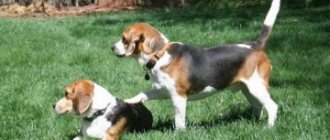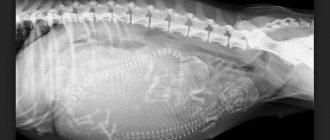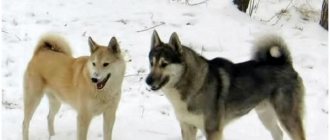A breeding female of the Cane Corso breed is purchased for subsequent breeding and production of high-quality offspring.
When selling a puppy, experienced breeders must indicate whether it has the makings of a real breeding breeder or whether it will become a star in the ring , or perhaps become a pet.
This clarification is important, since the owner, immediately after the first heat, begins to look for a suitable male, negotiate with his owners, plan the time and calculate the amount he is willing to pay for mating.
What determines the number of puppies in a litter?
Neither the owner himself nor the veterinarian will be able to guess just by looking at a pregnant bitch how many fetuses are in her womb. However, you can try to find out how many puppies a dog can give birth to, based on the following data:
- Dimensions (breed) of a pregnant dog
. As a rule [1], the number of puppies per litter is higher for large breed dogs (7-8 or more) because, from a biological point of view, they can safely bear more puppies. Miniature pets usually give birth to 1 to 4 babies. Although there are exceptions to this rule. There is evidence that some baby Pekingese can give birth to up to 10 puppies; - Bitch's age
. Usually there are few puppies in young dogs under the age of 1.5 years (1-2 puppies in small breed dogs and no more than 4 in large breeds). And dogs over 5-6 years old, as a rule, also have few babies in their litter. Maximum [1] puppies are born to bitches who are between 2 and 5 years old; - Male age
. The number of puppies also depends on how old their father is [1]. Young males aged 1-1.5 years and older dogs have low sperm quality, which affects the number of offspring; - Order of birth
. The first time, bitches, regardless of age, give birth to fewer puppies than the second time. And the third or fourth births account for the most numerous litters [1]. After this point, litters tend to get smaller with each successful mating. For example, tiny Chihuahuas in the first litter produce no more than 2 babies, and in the third they can already give birth to 3-4 cubs; - The dog's health during pregnancy and before birth
. Everything is simple here: the physically stronger the dog, the stronger its immunity, the higher the chances that it will be able to safely bear a large number of puppies. Thus, a healthy small mongrel is capable of giving birth to more puppies than a purebred large dog, whose condition leaves much to be desired. Ideally, before mating, the owner should show his four-legged pet to a veterinarian and make sure that everything is in order with her health; - Dog weight
. Few puppies in a litter usually occur in dogs whose weight is far from normal. Moreover, this applies to both animals with insufficient body weight and pets with obesity; - Season
. There is evidence [1] that in the spring bitches give birth to a larger number of cubs in comparison with other times of the year (the smallest number of doggies is born in the cold season, that is, in late autumn and winter); - Natural or artificial fertilization (insemination)
. Almost always [2] with natural insemination, when a bitch has contact with a male, more puppies are born in the litter than with artificial insemination. This is due to the fact that during artificial insemination, sperm partially die during the collection and storage of the male’s semen.
Helping breeders determine the correct breeding day
To determine favorable mating days using vaginal smears, you must have:
1. Take a clean glass slide, well washed and wiped dry, and place it on a clean napkin. 2. Take a cotton swab, dip it in distilled water, shake the stick in your hand several times to remove excess water. 3. Using a damp stick, take a swab from the bitch, inserting it deeper into the loop (2-3 centimeters), as if wiping the loop from the inside, without touching it with your hands (from the upper arch). 4. Roll this stick over the slide (without pressing too hard, so that the layer of the smear is not thick. Visually, you will see a cloudy strip on the glass - this is your smear, which needs to be painted over. 5. Apply one drop of dye to the smear with a pipette, Cover carefully with a cover slip to avoid any air bubbles.
AND YOU CAN LOOK THROUGH THE MICOSCOPE... What cells can we see there:
1. Parabasal (round with a large nucleus, small in size)
2. Intermediate (rounded, with a more transparent cytoplasm, the nucleus decreases, the cell increases due to plasma, larger than parabasal cells) 3. Superficial cells (estrous scales) - this is exactly what interests us. During fertile days, almost all cells should be exactly like this; intermediate cells may be present in a single quantity. Estrous scales line up in chains (gluing), but in some bitches gluing does not occur, but fertilization occurs. The cells seem to overlap each other (like tiles), located perpendicular to each other, the contours of one cell are easily visible through the transparent cytoplasm of the other. At a magnification of 80-120 we look at the general background, at a magnification of 300 and above we look at the cells. During the rest period, we will see single cells against the background of leukocytes (leukocytes are smaller, like splashes or sand scattered across the field of a smear).
Examples of strokes
Day 1 ( In this case, this is the first day of taking a smear, and not the beginning of estrus, it coincided with the end of proestrus ). Usually, smears begin to be taken from the 6th-7th day of estrus. Proestrus (intermediate cells and a large number of erythrocytes and leukocytes, superficial cells - single). Red blood cells and white blood cells are small, in the form of sand.
On the smear, the leukocytes are the smallest and dark blue in color. The background of the stroke is translucent (cloudy). Day 2 - Beginning of estrus (there are many surface cells, but there are still a large number of intermediate cells, there are noticeably fewer leukocytes, the background of the smear clears, becomes blue and cleaner, more transparent)
Day 3 Estrus, the beginning of fertile days. Conception is likely. (almost all cells are superficial - polygonal, nuclear-free. Intermediate cells and leukocytes are in small quantities, the background of the smear is clean, light blue).
Day 6 Estrus, fertile days (almost all cells are superficial, leukocytes have practically disappeared, the background of the smear is clear, light blue, like the sky). The ideal time to conceive.
Day 9 Estrus, end of fertile days (almost all cells are superficial - polygonal, nuclear-free. A small number of intermediate cells are round, with a small nucleus. Leukocytes appear in small numbers, the background of the smear is transparent, light blue).
Day 10 Estrus, end of fertile days (almost all cells are superficial - polygonal, anucleated. Keratinization intensifies. The number of leukocytes increases, intermediate cells appear. The background of the smear becomes not as transparent as it was).
Day 11 Diestrus. Conception is impossible (almost all cells are intermediate and basal, a large number of leukocytes. The background of the smear becomes dirty and cloudy).
Day 12 Diestrus, 2nd day. Conception is impossible (all cells are intermediate and basal, a large number of leukocytes. The background of the smear is dirty and cloudy).
Examples of cytological smears with explanations.
Estrus, fertile days, all superficial cells are polygonal, the background of the smear is light, transparent. The cells seem to overlap one another. A day favorable for conception. Diestrus, conception is impossible.
The cells are parabasal (with a large nucleus, round and intermediate (with a small nucleus). Superficial cells are absent or present in single numbers. A large number of leukocytes, the background is cloudy and dirty. The fertile period has passed. Some of the signs of days favorable for mating are:
Signs of the end of fertile days are: - The number of surface cells gradually begins to decrease and the number of intermediate cells increases. — Due to changes in the nature of mucus and the appearance of leukocytes, the smear acquires a cloudy, darkish background. — Subsequent decrease in the number of superficial cells and an increase in the number of intermediate ones.
Below is information from the book “English Bulldog” by Bailey S. Haynes from the series: American Kennel Club Library.
If an unusually large number of leukocytes are present in the smear during proestrus, or generally during the cycle, the bitch probably has some kind of infection, although at the same time, during the optimal period for mating, the smear may look completely normal. At the same time, if a bitch has an infection, neutrophils, intermediate or parabasal cells can often appear at inappropriate times. “Grouping” of anucleated cells is not observed; examination of vaginal smears becomes ineffective.
Another method is to breed the bitch immediately after a smear test indicates she is out of cycle.
You should pay attention to the smear of an infected bitch: some cells, although nuclear-free, are unusually round. In addition, the abundance of leukocytes is striking. There are several types of white blood cells, but neutrophils are the ones most often present in a vaginal smear. Traces of leukocytes may be observed during proestrus. They appear towards the end of estrus - “at the exit”. However, during the most optimal period for mating, there are no leukocytes in the smear. Erythrocytes (red blood cells) may or may not be present throughout the cycle and have little effect on the results of the smear test. They are very small compared to white blood cells and are practically invisible when using methylene blue.”
Approximately the third day of estrus (proestrus): A dirty background of cell debris and torn cell edges. As the heat approaches the optimal day for mating, this dirty background will clear and the edges of the cages will become sharp and clearly defined.
Next stage (beginning of estrus): the grouping of cells continues, the background has cleared, the cells gradually become nuclear-free (but nuclear cells are still present), some of them look like mutually perpendicular strokes.
On the trail. stage (estrus), a large crowding of cells appears, they are almost all nuclear-free. From this day on you need to knit. (Harris-Shore staining, photos taken from the book “A Practical Guide to Breeding Dogs”, Royal Canin) Estrus (general picture)
Estrus (picture enlarged)
Diestrus (general picture)
Diestrus (picture enlarged)
Other methods to help determine the readiness of a bitch for mating.
1. An ancient method for determining the timing of ovulation from veterinarians in the field. We take clean glass and apply it to the loop so that the mucus is imprinted there. Spread the mucus a little on the glass and wait until it dries. If it crystallizes, it's time to run to the cobble. If it dries up like just a dirty stain like “from milk,” for example, then it’s either too early or too late.
2. You can use “Uriglyuk-1” test strips (or any others) to determine the level of glucose in urine - for diabetics (sold in a human pharmacy). There is a color scale on the jar itself - you can attach your strip to it and accurately determine the degree of “greening”... or browning... When the microscope shows the most favorable time for mating, the color of the test strip is already on the decline. With a super green stripe, according to a smear test in a microscope, it’s still a little early. Those. the test shows the maturation of the egg and, in principle, full readiness for mating, but there are still a couple of days before its release, and the smear is exactly the peak of release. “Uriglyuk is a small tube with a tight lid, there are strips of waterproof paper with a small indicator on one of the ends of the strip. On the tube itself there is a color scale by which comparison is made. Immerse the strip with the indicator directly “there” to a depth of 2-3 cm. The fact is that, according to the instructions, this thing is used to determine sugar in urine. And they recommend immersing it in urine for 5–6 seconds. Those. It is assumed that for the reliability of the result, the indicator material must still be saturated with the test liquid. And since our liquid is thicker than urine, we must wait no less than these seconds, or even more (7–8, for example). And it is desirable to ensure maximum contact between the indicator and the material, which is achieved precisely by immersion “there”. Or, if there is enough discharge on the surface of the loop, then put the indicator strip directly into them, throwing the dog on his back. We see the result within 2 minutes.
3. You can use an Arbor microscope or a regular microscope to examine the crystallization of saliva. During the period favorable for mating, the appearance of saliva under a microscope will be the leaves of a fern. The dog's saliva is taken on an empty stomach.
5. During the ovulation stage, eggs are released immature, but ready for fertilization, usually 48 hours later. Ideally, mating or artificial insemination should be carried out within 48 hours of ovulation, which allows the majority of fertile eggs and sperm to reach the meeting place (fallopian tubes). Eggs, from the moment they mature, are capable of fertilization within 2 days (in some breeds, this ability can apparently be maintained for over 4 days). Clearing of the discharge from the loop usually means the end of proestrus, but cannot serve as a reliable control of ovulation (in some bitches, such as chow-chows, spotting is possible until the end of estrus). Ovulation most often occurs on days 1-3 from the start of heat (sometimes on days 5-7 or even 2 days before it). Typically, mature follicles ovulate within 24 hours. However, eggs become capable of fertilization only after 2-3 days. The general lifespan of an egg after release from the ovary is 5-8 days.
Indicators for insemination with live sperm (veterinarians of the Kanikold system).
19 ng/ml (>60 nmol) we inseminate today (now!)
For live sperm: Fertile period for mating 4-10 til 20 ng/ml
Insemination with frozen and chilled semen:
5 NG/ML (15 nmol/l) insemination from 2.5 to 3 days later 9-12 ng/ml (29 - 38 nmol/l) insemination on the next day. day 15 ng/ml (>52 nmol/l) insemination today
Source
Accurate ways to find out the number of puppies
Of course, you can't rely entirely on a dog's age and, say, its weight to know how many puppies there will be in a litter. More reliable information can be obtained using an ultrasound, which is performed on bitches after the 25th day of pregnancy (veterinarians sometimes use ultrasound only to confirm pregnancy, and not to count the number of puppies). You can even more accurately determine the number of puppies using x-rays, but such a study is most informative only after the 55th day of pregnancy, when the skeleton of the puppies is fully formed. By the way, during the X-ray examination, the doctor will determine the position of the fetuses and decide whether the dog will need help during childbirth.
By the way, some owners, trying to calculate the number of fetuses in the dog’s womb, use the palpation method by pressing on the belly of their pregnant pet. You shouldn't do this! And not only because it is very difficult to find puppies. Just strong pressure can damage fragile babies, as well as cause pain to a pregnant animal.
The need for vaccinations
Any dog is susceptible to infectious diseases, which can become dangerous for its owners.
The most dangerous diseases are rabies, plague, enteritis (parvovirus and coronavirus types), hepatitis, parainfluenza, leptispirosis.
To eliminate the risk of such infection, vaccination is carried out.
The vaccine provides long-lasting immunity. It can be monovalent (only against one specific infection) or polyvalent, having a complex effect.
Vaccinations are done in this way:
- The first vaccination is given at the age of 6-8 weeks. It includes vaccines against enteritis and hepatitis. Typically a divalent composition is used. Repeated vaccination is provided after 12-15 days. The animal adheres to quarantine.
- The plague vaccination is done at 2.5-3 months, and repeated at 7-8 months. After this vaccination you will have to stop walking for 18-20 days.
- The rabies vaccination is given at 6-8 months. If you have previously been vaccinated against plague, it can only be done at 8 months. Rabies vaccination is carried out every year and is mandatory.
- Other vaccinations. Vaccination against distemper, parvovirus, adenovirus and parainfluenza can be carried out at the owner's request at the age of 8-10 weeks. A one-year-old dog is vaccinated against leptospirosis.
IMPORTANT!
When carrying out vaccination, you need to remember that the interval between different vaccinations should be at least 14-15 days.
All procedures performed must be entered in the dog’s passport and confirmed with a stamp.
How many puppies do females of popular breeds give birth to?
Now let's look at how many puppies are born to dogs of these 30 popular breeds:
- Chihuahua – 2-5 puppies [4] ;
- Yorkshire Terrier – 2-5 puppies [4] ;
- Russian Toy Terrier – 2-5 puppies;
- Pekingese – 2-4 puppies;
- Pomeranian Spitz – 2-3 puppies;
- Pug – 4-6 puppies;
- Dachshund – 2-5 puppies;
- American Cocker Spaniel – 3-7 puppies [4] ;
- French bulldog – 3-6 puppies;
- Welsh Corgi – 2-5 puppies;
- Jack Russell Terrier – 2-5 puppies;
- Beagle – 5-7 puppies;
- Bull Terrier – 3-7 puppies;
- Sheltie – 2-6 puppies [4] ;
- Akita Inu – 3-7 puppies;
- Shar Pei – 3-5 puppies;
- Siberian Husky – 7-9 puppies;
- Dalmatian – 8-12 puppies;
- Pitbull – 7-10 puppies;
- German Shepherd – 4-9 puppies [4] ;
- Collie – 6-10 puppies;
- Great Dane – 8-12 puppies;
- Doberman – 7-9 puppies;
- Labrador Retriever – 5-10 puppies [4] ;
- Golden Retriever – 7-12 puppies;
- Rottweiler – 8-11 puppies;
- Cane Corso – 8-12 puppies;
- Central Asian Shepherd Dog (Alabai) – 9-12 puppies;
- St. Bernard – 9-12 puppies;
- Bullmastiff – 5-13 puppies [1].
Of course, data on the number of puppies in females of various breeds is very approximate. For example, for the first time a young collie may have one puppy in the litter, but in the future she will be able to give birth to 10 babies at once. And a Pekingese dog, as already mentioned, can give birth to a dozen children, although on average these bitches bear up to 6 puppies.
Peculiarities of Cane Corso breeding: estrus, mating, pregnancy and childbirth
A breeding female of the Cane Corso breed is purchased for subsequent breeding and production of high-quality offspring.
When selling a puppy, experienced breeders must indicate whether it has the makings of a real breeding breeder or whether it will become a star in the ring , or perhaps become a pet.
This clarification is important, since the owner, immediately after the first heat, begins to look for a suitable male, negotiate with his owners, plan the time and calculate the amount he is willing to pay for mating.
How long does a Cane Corso girl's first heat last?
Cane Corsos mature and mature late, like most large dog breeds. A six-month-old female Cane Corso is still considered a puppy, and only at eight months does the girl begin puberty, the main sign of which is the first heat .
Pustovka is also called the first heat, during which ovulation may not occur, since the teenager’s body is still forming, the reproductive system, subject to hormonal changes, becomes perfect.
The time of the onset of the first heat is always individual; emptying can begin at eight months or after a year. Beginning breeders are always interested in how long the Cane Corso's first heat lasts. On average, the process lasts three or even four weeks, but for each dog it proceeds differently.
Most often, during emptying, spotting is scanty, almost invisible . Occasionally, owners notice a few drops of blood on the floor, but it also happens that after a three-week sluggish process, the discharge from the bitch’s loop intensifies, becomes dark and profuse. This is also a variant of the norm, since the hormonal background has not yet been established.
A big dog has a big apartment
That is, you will have to walk with her a lot, and not just wander around, but play and let her run around to her heart's content. If the owners are away from home all day and the entire walk comes down to a half-hour promenade before bed, this is absolutely not suitable for a Cane Corso. In this situation, he can splash out energy in an undesirable way: spoil household things. And, to be fair, you can’t blame him for this.
Aviary keeping is also not suitable. Although various sources may write that a dog can be kept outside in a warm kennel, in reality it is better for him to live indoors. The fact is that representatives of this breed have smooth wool without undercoat, it practically does not warm, and is completely useless when the cold comes. In cold weather, the dog will suffer severely, and it is unlikely that an insulated kennel will greatly save the situation, especially if the Corso lives in a region with cold winters.
How to choose the right male
After the bitch has finished her first heat, the owner thinks about selecting a pair for his pet. In the RKF system, to which most Russian clubs belong, there is a rule: before eighteen months, mating of Cane Corso (females) and other large breeds is prohibited .
That is, even if the dog starts her next heat before this age, she will have to miss it. The ban is due to the late physical development of the Cane Corso , as well as the need to obtain permission for breeding. To do this, the bitch must receive a show grade and pass obedience tests.
A stud dog is selected based on the following criteria:
- The male must be better than the female in appearance. A stud dog must have titles no lower than “Junior Champion” for young dogs and “Champion” for dogs over two years of age. A male dog that has one or more “excellent” ratings, but does not have titles, has exterior defects. Of course, even titled males have shortcomings, but they are insignificant, and the advantages of the exterior clearly prevail.
- The male must be prepotent. Prepotency is a concept that means that a male dog necessarily passes on his best qualities to his offspring. Simpler - most puppies from such a male will look like him. This quality can be easily verified by asking the descendants of the manufacturer how many of them have awards and titles.
- The male must be of the same type as the female. There are several types of the Cane Corso breed that differ in general build. For example, there are massive, heavy dogs, and there are drier, more elegant ones.
After a verbal agreement with the owner of the dog, the owner of the bitch must take a referral for mating at the nearest club and fill it out. Mating is carried out on the tenth or twelfth day of estrus, repeating it every other day. The completed mating certificate, along with copies of the pedigrees of both dogs, original diplomas with an assessment and copies of all title diplomas, is taken to the club, where after the birth of the puppies they receive birth certificates for the babies .
Boys are for the strong-willed, girls are for the family-minded
If the choice of breed has already been made, the second question that worries the future dog owner is whether to take a male or a female? It is impossible to say which of them is definitely better. It all depends on the character of the owner himself and the purposes for which he decided to get a pet.
Males of the Cane Corso breed have all typically masculine qualities, so the owner must be prepared for the fact that he will have to show will and strength of character, but in no case aggression. But even when he earns authority from his dog, he will not become a resigned puppy. From time to time you will have to prove to him that the owner is worthy of the Cane Corso recognizing his dominance. At the same time, it is very important that the dog’s attempts at dominance are suppressed without the use of brute force. The dog will perceive aggression as aggression, but fear and respect are very different things, and the animal can prove this on occasion.
If there is no desire to measure authority or there are children in the family, you should choose a bitch. Cane Corso girls are more flexible, obedient, and you won’t have to compete with her and find out who’s the bigger man. In addition, females need slightly less physical activity than males.
Nature itself has decreed that female representatives are endowed with maternal instinct. It is not surprising that the desire to care for and protect weak family members - children - is more clearly expressed in females. They are more patient and affectionate.
Pregnancy and childbirth
If mating was carried out at the time of ovulation, then estrus ends with the onset of pregnancy. Pupping in dogs lasts two months or eight to nine weeks. Multiple pregnancies last several days less;
bitches carrying one or two puppies live a little longer. For the first four weeks, there are almost no signs of pregnancy. The bitch may become calmer, sometimes refuses to eat, and becomes sad. But by the behavior of many Cane Corsos it is impossible to determine that the dog will soon become a mother: they are still cheerful and active.
After the fifth week, an experienced owner can already notice the first signs of pregnancy: the nipples begin to enlarge, and the volume of the abdomen in the area of the ribs becomes larger. But it is possible to clearly see a bitch’s pregnancy from the seventh week. The abdomen enlarges, the mammary glands swell. At the eighth week milk appears.
Sixty days after fertilization, the bitch is ready to give birth to her offspring.
Her hormonal background changes, and under the influence of hormones the uterus begins to contract. The approach of childbirth can be determined by the dog's fussy, restless behavior. She begins to rush around, looking for a place for herself, digging up the litter.
At this time, you can notice that she began to have slight mucous discharge from the loop. This is a sign of the mucus plug coming out. Pre-partum contractions last approximately six hours, after which the puppies begin to be born. Childbirth itself begins with pushing: the bitch pushes, trying to push the fetus out of herself. During this time, the owner must be with the dog to help it if necessary . The bitch herself gnaws the umbilical cord, frees the puppy from the amniotic sac and eats the afterbirth.
Useful video
Video about Cane Corso pregnancy:
Every owner of a bitch sooner or later encounters heat. It’s good if you already have experience and all the necessary knowledge, but many are faced with this for the first time and wonder how many days does a dog go into heat, what signs precede it, etc.? Some owners may panic because they have no idea when their dog is in heat.
- First heat
- Signs of heat
- Duration
- Hygiene and care
- Mating
- Estrus after childbirth
Estrus, also known as estrus, is a natural process among females when a female is ready for fertilization and procreation. During this period, the instincts and character of the animal change. Dog owners should consider several factors and spend more time on hygiene and caring for their pet.
Childbirth period
About a week before the onset of labor, the dog should be given a place in a cozy, warm, dry and clean room, protected from drafts. Only her owner can enter the room where the bitch is: strangers should not disturb the dog before giving birth and during the first days after it.
In addition, it should be taken into account that after the appearance of puppies, the bitch often shows aggressiveness towards strangers, instinctively protecting her offspring. It is advisable to leave the dog in the room where the birth will take place for another 2 weeks after the birth of the babies.
For your dog, it is best to make a wooden birthing box that matches the size of its body. The puppying bitch will be in a box and will be able to rest her paws on its walls. It is advisable to make the front wall in such a way that it can be folded back or removed, and then put back in place. This will make the birth box easier to clean and disinfect.
Before the onset of childbirth, it is recommended to cover the bottom of the box with a tarpaulin, oilcloth or plastic film, and lay on top a soft cloth folded in several layers, a piece of an old bedspread or blanket. A week before giving birth, you need to regularly measure the dog’s temperature, in the morning and evening, paying attention to its sharp drop. The normal temperature is 38.5 °C, but about a day before the onset of labor it drops to 36.5-37 °C.
As a rule, in the last week of pregnancy, the bitch experiences a loss of appetite, so you should give her food in small portions, including the dog’s favorite treat - a piece of cheese, boiled liver, cottage cheese, etc.
Childbirth can take place naturally, that is, without assistance from the owner. He just has to stay next to the dog and monitor whether the birth process is going normally. It also happens that childbirth goes well, but the owner still has to provide assistance to his ward. In the event of a difficult birth, when the dog experiences certain complications, it is necessary to invite an experienced veterinarian.
Before labor begins, you should prepare all the supplies necessary for labor and delivery and keep them on hand. To do this, you will need dry and clean pieces of gauze and towels, a large cardboard box to place the puppies, and scissors with rounded ends (they are used to cut the umbilical cord). In addition, just in case, you need to prepare cotton wool, iodine tincture, Vaseline and a thick thread for tying the umbilical cord. A bowl of clean water should be placed near the birth box, which should be changed as needed.
You also need to prepare a warm soap solution and a solution of potassium permanganate in a ratio of 1: 1000, which is used to alternately wash the external genitalia, perineal area and croup of the dog before giving birth. If the bitch needs her owner's help during childbirth, it is necessary to ensure that her hands are clean. You need to wash them thoroughly with warm water and soap, trim your nails short and treat the skin of your hands with cotton swabs soaked in alcohol.
The following symptoms indicate the onset of labor: the dog becomes restless, refuses to eat, and has rapid breathing and muscle trembling. The mammary glands are noticeably enlarged. The dog begins to scratch its paws along the litter of the maternity box, trying to get more comfortable in it. When the bitch lies down on the bottom of the box, then upon a superficial examination of her belly, you can even notice the movement of the fruits in it.
The entire process of childbirth includes three main stages: preparatory, gestation and postpartum. The preparatory stage begins with contractions. The muscles of the uterus contract, then the cervical canal opens, coming into contact with the amniotic sac. The period of contractions usually lasts from 6 hours to 1 day, sometimes up to 28-30 hours. This is followed by the period of fetal hatching. After the cervical canal opens completely, contractions begin to be accompanied by periodic contractions of the abdominal muscles - pushing. The fruits begin to alternately move through the birth canal and emerge. Both cephalic and breech presentations of fetuses occur: in both cases, childbirth can proceed quite normally. Rupture of the membranes occurs either while the fetus is still moving through the birth canal, or after the birth of the puppy. The mother herself gnaws the umbilical cord and licks the newborn baby, removing mucus and remnants of the amniotic sac from its body.
A normal, uncomplicated birth process lasts the same number of hours as there are puppies in the litter. After the birth of the fetus, the placenta comes out. In some cases, the afterbirth is removed from the birth canal a little later, after the birth of the next puppy. As a rule, the afterbirth is eaten by the dog.
Posts 1 page 4 of 4
Share109-01-2010 19:12
Some people will probably be quite skeptical about the need to devote two chapters to the subject of dog breeding. Most have a strong belief that nothing more than leaving two dogs alone is required and everything will be fine. However, many dog breeders, unfortunately, and not without damage to themselves, have become convinced that this is far from the case.
Under normal conditions, most males and females can breed as nature intended without assistance. However, all matings must be observed, at least from some distance: firstly, to ensure that mating has occurred and, secondly, so that the dogs do not in any way harm each other. Dogs living in the same kennel usually mate without any difficulty.
Types of stud dogs
Stud dogs can be divided into four types.
The first type is an active and experienced male who does not require any preliminary ceremony and does his job efficiently and without fuss. This type of dog needs to be restrained a little, especially with a nervous bitch or a bitch who is mating for the first time. It is extremely easy to manage such active and business-like dogs.
The third type is a spoiled male, which would be a normal male if he were raised under normal conditions. Maybe because he has never been trained to do breeding work and is a very beloved and spoiled darling, he needs to be cheered up to a certain extent. A male of this type should be tried for the first time to be mated with an easily controlled bitch, perhaps also a second and third time, until a successful mating takes place. Such males should never be bred with equally “spoiled” or aggressive females, especially during his first few matings, so as not to be completely turned off from breeding work. If such a dog is bred before two years of age and given several temperamental but flexible bitches at short intervals, he can become a very good stud dog.
How to “untie” a male dog.
It is better if it is one of those bitches that the dog knows well; maybe one of his buddies from the nursery. A male dog should not be kept near females in heat before mating, as this may reduce his interest. When it is necessary for mating to occur, the dogs are placed together in a small fenced area or room and they are monitored. You need to let the young male groom the bitch for a while. The place where everything happens must be well known to the dog, that is, the bitch must be brought to the dog.
It is very funny to see how a well-trained stud dog, especially one of the toy breeds, clearly asks his owner for help, as he does not want to waste his energy!
It is very important not to allow the male to continue unsuccessful attempts for too long, no more than five minutes, since the male must not be allowed to overexert himself without results; if his attempts are prolonged, the bitch should be taken away.
During rest, you can feed the male dog a little. For some unknown reason, males become more determined after eating, but, of course, there should not be a lot of it in volume.
Then the dog needs to be taught that, while in the lock, he allows himself to be touched, the lock is checked, his front legs are allowed to be removed from the bitch and, perhaps, he is turned or helped to turn.
If the dogs are large and mated on the floor, it is important that there is enough light from the window; on dark days, electric lighting may be needed, especially if mating is difficult. It is also important that both the door and window are locked and that the room is warm enough.
The instructor and assistants need two or three chairs. To avoid being bitten in case of difficult mating, you need to have gloves. It may be necessary to support one of the dogs if there is a large difference in height. This could be a thick wooden board, a decoy with sand or shavings, or a straw mat - all of this will work to elevate one of the dogs. The bitch must have a leather collar and a leather leash. Never, ever breed a bitch with a choke collar and a chain instead of a leash.
A good lubricant for the vagina is medical vaseline oil (preferably “Liniment synthomycin 10%”; editor’s note).
helps the dog. With assistance, toy dogs rarely need muzzles or gloves. In case the dog or instructor is bitten, you need to prepare some kind of antiseptic.
The refusal of a planned male to mate a bitch brought to him does not happen often, but it does happen, and in such cases the owner of the male, if a replacement agreement has not been reached in advance, does not know what to do, especially if it is not possible to contact the owner of the bitch because he unavailable by phone, or left, or left.
If either party does not have a telephone, efforts should be made to arrange telephone contact through friends.
Source
Read also
End of labor
The end of labor The end of labor is indicated by the fact that the bitch begins to breathe calmly and evenly, calms down, curls up around the babies, pressing them to her chest, proudly examines and sniffs them, and they, having distributed the nipples, either silently enjoy the colostrum, or
Signs of approaching labor
Signs of approaching birth About 1 month before giving birth, the dog’s belly becomes enlarged. When there are 3 weeks left before giving birth, vaginal swelling begins and discharge appears. A bitch’s mammary glands swell 10–15 days before giving birth. One of the indicators of impending birth is
Childbirth process
The process of childbirth The birth process is divided into 3 stages:• preparatory;• stage of fetal excretion;•
Signs of approaching labor
Signs of approaching birth About 1 month before giving birth, the dog’s belly becomes enlarged. When there are 3 weeks left before giving birth, vaginal swelling begins and discharge appears. A bitch’s mammary glands swell 10–15 days before giving birth. A decrease in body temperature is also a sign
Childbirth period
The period of birth Approximately 1 week before the onset of labor, the dog should be given a place in a warm, dry and clean room, protected from drafts. Only her owner can enter the room where the bitch is located - strangers should not disturb the dog before giving birth and during
Childbirth period
The period of birth About a week before the start of labor, the dog should be given a place in a cozy, warm, dry and clean room, protected from drafts. Only its owner can enter the room where the bitch is located: strangers should not disturb the dog before giving birth and during
Complications during childbirth
Complications during childbirth Most guinea pigs give birth easily and smoothly, but in some cases, complications may arise that threaten the lives of the mother and cubs. Therefore, it is important for every guinea pig breeder to be able to not only recognize the generic
Progress of labor
The course of childbirth 3-5 days before the onset of birth, the cat’s behavior changes. She is very preoccupied with finding a secluded place, climbs into all the drawers and cabinets if a “burrow” is not prepared for her. Before giving birth, you should prepare: soft cotton napkins; a small cardboard
SIGNS OF APPROACHING BIRTH
SIGNS OF APPROACHING BIRTH As the day of birth approaches, the cat begins to become more and more nervous; she may begin to scratch and tear the paper in the box prepared for her and the kittens, meow pitifully, and refuse to eat. The cat can climb into closets, laundry drawers, closets,
Shortly before birth
Shortly before giving birth Now you should prepare everything that is needed or may be needed during the birth of a dog.1. Oilcloth. It is needed only during childbirth, so as not to stain the place where the dog will whelp (in no case should oilcloth be placed under puppies).2. Large
Duration
The main question that interests all owners of females is how long does estrus last in dogs? Regardless of the breed, all dogs, from the miniature dachshund to the large shepherd, estrus lasts about 20-22 days.
The first eight days the bitch is not ready for fertilization and often avoids any contact with the cables. By the ninth day, the female becomes ready for mating, and within 7–8 days peak sexual activity is observed. Then activity drops, and the female's chances of becoming pregnant decrease.
To better understand how estrus proceeds and when favorable days for mating occur, let’s look at periods of estrus in dogs.
- Proestrus is the first stage during the estrus period. It lasts about eight days from the start. During this period, heavy bleeding is observed. They can be seen everywhere the dog has been. Therefore, it is worth limiting the radius of movement or using special underwear. For the first eight days, the bitch is not ready for mating, so she may be aggressive or, conversely, depressed.
- Estrus is the second stage and lasts about 7–8 days after proestrus. The female begins to peak sexual activity. This can be noticed by certain signs, for example, the bitch begins to move her tail to the side, whine, and lie on her stomach.
- Diestrus - the third and final period of estrus lasts several days. The female ceases to feel interest in males and becomes more and more passive about mating. During this period, you should not breed a female, especially if it is a purebred dog such as a dachshund, cocker spaniel, labrador or shepherd.
The period between heats is called anestrus. A healthy young dog should come into heat twice a year. Older dogs gradually enter estrus once a year. If this happens more or less frequently, you should contact your veterinarian.











